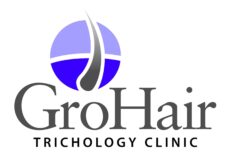What is Scalp Microneedling?
Microneedling (previously known as collagen induction therapy) has been used in dermatology and facial aesthetics for around 25 years and is well known for its benefits in improving the appearance of minor scars, fine lines, hyperpigmentation and skin tone. Scalp Microneedling has more recently emerged as a useful treatment for hair loss, which has shown to notably improve hair regrowth, especially when used alongside other treatment modalities such as topical Minoxidil, due to its effect of increasing transdermal permeability.

Scalp microneedling is a minimally invasive procedure where very fine medical grade needles are moved over the scalp puncturing the skins surface to create lots of tiny microinjuries/channels. This process initiates the skins natural healing mechanisms, stimulating growth factors, collagen production, and improving localised blood supply.
During your treatment we use a nourishing mesotherapy serum, to help soothe the scalp and encourage an optimal hair growth environment.
What’s the science?

When treating hair loss conditions, the microneedles are inserted to a depth of around 1.5mm, to reach the bulge region (where the hair follicle stem cells are located), and the dermal papilla.
How microneedling actually works for hair growth is not clearly understood, but the most commonly agreed hypothesis is thought to involve the skins natural healing mechanisms. The action of puncturing the skin to create lots of tiny micro wounds, sets of a cascade of responses which increases cellular communication and proliferation of cellular growth factors such as platelet derived growth factor (PGF), and transforming growth factor (TGF). Specialised cells like platelets (blood clotting cells), and fibroblasts (lay down collagen fibres) travel to the site of injury to start the repair process. Additionally, surrounding blood capillaries dilate to facilitate the migration of keratinocytes (produce keratin involved in hair fibre production) and other cells to assist in the healing process.
The action of microneedling is also thought to increase expression of WNT pathways which facilitates communication between the dermal papilla and stem cells of the hair follicle, effectively regulating the normal hair cycle.
What type of hair loss is microneedling suitable for?
Scalp microneedling is shown to be more effective for androgenetic alopecia (male/female pattern hair loss), and alopecia areata (patchy hair loss). It may also be useful in some cases of chronic telogen effluvium.
Microneedling is best used as a co-therapy alongside other topical medications such as Minoxidil, as it increases transdermal absorption of these treatments. There are less studies available for the use of microneedling as a monotherapy, so judging efficacy in this setting is a little difficult. Nevertheless, I am keen to monitor this in clinic over the coming months to gain a better perspective.
How long will it take to see results, would I need continuous treatments?
This is dependent on many factors such as age, general health, and the type, duration and severity of hair loss being treated. As a general rule, an improvement is more likely to be seen after 3 months of treatment. A course of 3 treatments is recommended (1 every 4 weeks), with maintenance once every 3 months. More than 1 course may be advised in some cases, before continuing with maintenance treatments.
It should be noted that this treatment is not guaranteed to be effective for everyone.
Is the procedure painful?
There may be some minor discomfort from scalp microneedling due to the depth of the needles used. A topical anaesthetic is used prior to treatment which significantly helps to minimise any pain. It may also be useful to take a paracetamol an hour or two prior to your treatment.
How much does scalp microneedling cost?
A full consultation is required prior to scalp microneedling, to assess the suitability of this treatment. Please click here to book a consultation
Course of 3 treatments – £220
Single treatment – £80
Please see below some of the more recent clinical studies involving Scalp microneedling:
Microneedling for Hair Loss (wiley.com)
Microneedling and Its Use in Hair Loss Disorders: A Systematic Review – PMC (nih.gov)
